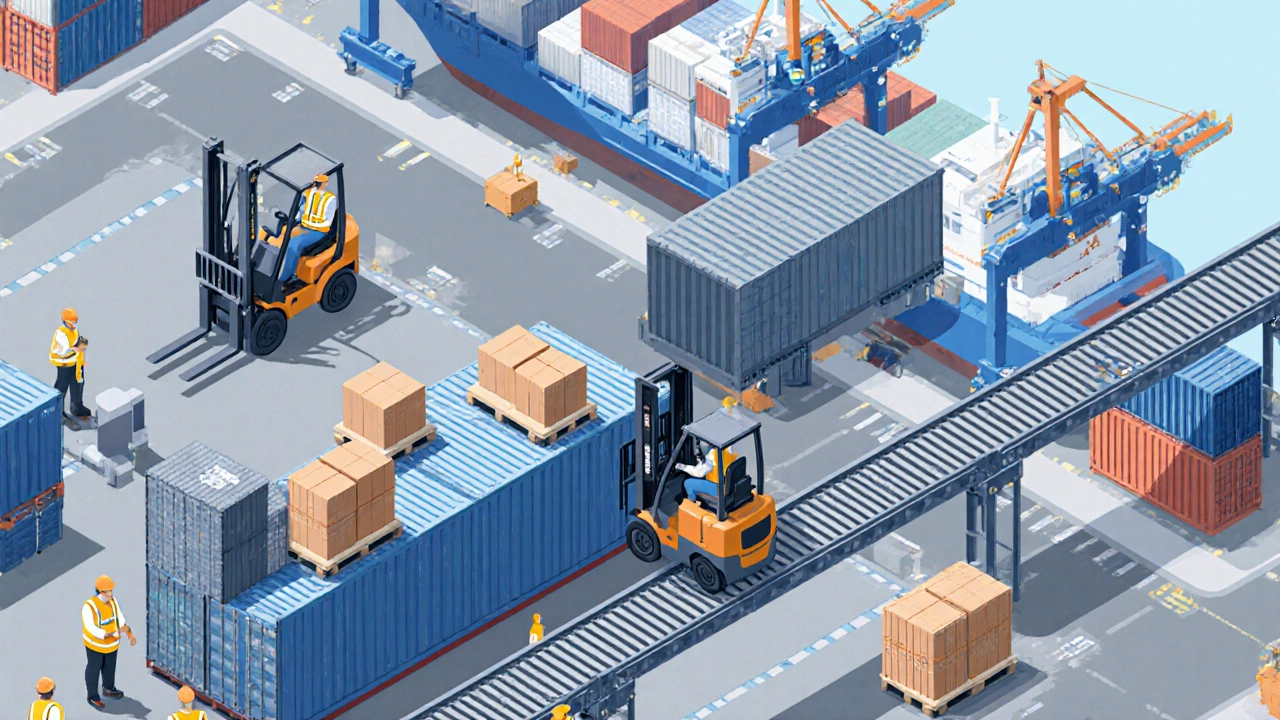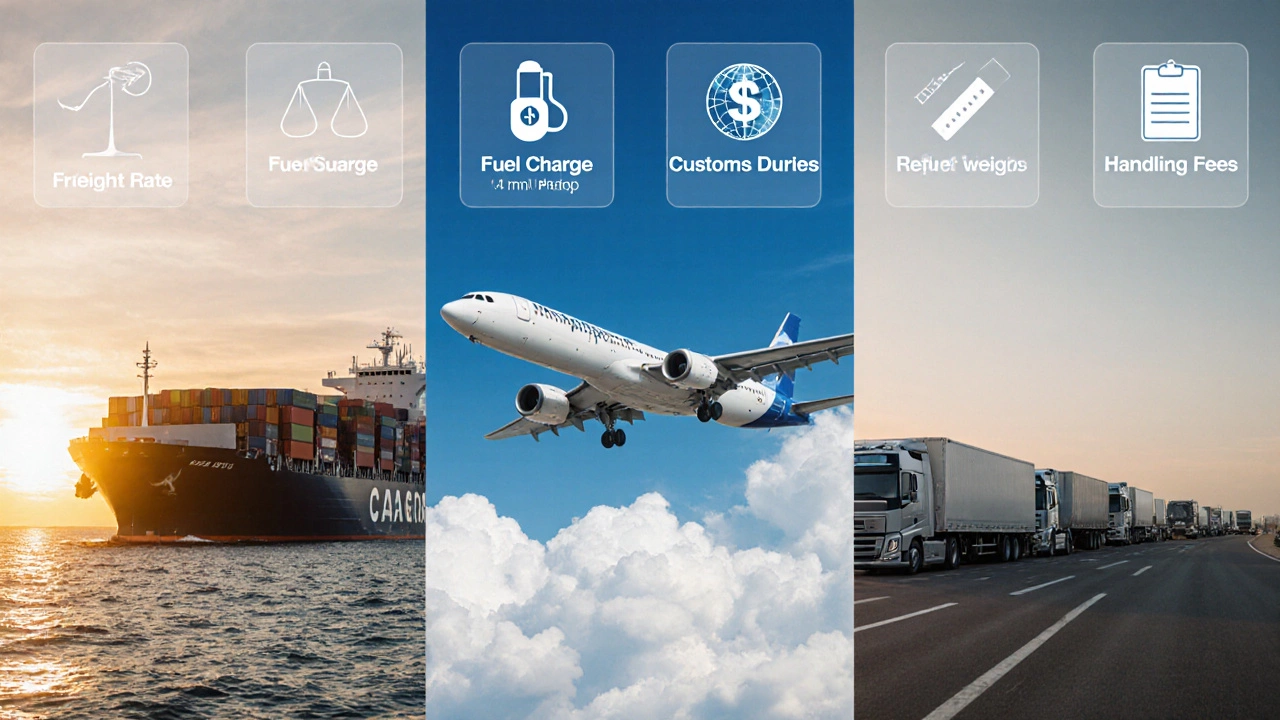Dimensional Weight Calculator
Results
How dimensional weight works: Carriers bill based on whichever is larger between actual weight and dimensional weight. If your package is light but bulky, you'll pay based on the volumetric calculation.
Key Takeaways
- Identify the main cost drivers - freight rates, fuel surcharges, duties, and dimensional weight.
- Pick the right Incoterm to shift responsibility and fees to the party best equipped to handle them.
- Consolidate shipments whenever possible; a single container can be 30‑50% cheaper than multiple parcel shipments.
- Negotiate carrier contracts based on volume, lane density, and service level.
- Leverage technology - rate calculators, AI‑driven routing, and real‑time tracking - to keep margins tight.
When managing cross‑border orders, Overseas Shipping Costs are the total amount you pay to move goods from one country to another, covering freight, duties, fuel surcharges, and handling fees. Understanding every piece of that bill is the first step to shrinking it. Below you’ll find a step‑by‑step playbook that works for anyone shipping from New Zealand to Europe, North America, or Asia in 2025.
1. Break Down the Cost Drivers
Each shipment is a bundle of fees. The most common components are:
- Freight Rate - the base price set by the carrier, often measured per kilogram or per cubic meter.
- Fuel Surcharge - a variable fee linked to global oil prices; it can swing 5‑15% month over month.
- Customs Duties & Taxes - calculated from the tariff classification and the declared value.
- Dimensional Weight - carriers bill by the larger of actual weight or volumetric weight (L×W×H ÷ factor).
- Handling & Documentation - paperwork, palletizing, and terminal fees.
By isolating each line item, you can target the one that offers the biggest saving opportunity.
2. Choose the Right Incoterm
Incoterms dictate who pays for which part of the journey. The most common for overseas e‑commerce are:
- EXW (Ex Works) - buyer bears all transport costs; good for sellers who want to offload risk.
- DAP (Delivered at Place) - seller covers freight and duties, buyer only handles final‑mile delivery.
- DDP (Delivered Duty Paid) - seller absorbs every cost; attractive to customers but can erode margins.
Switching from DDP to DAP for high‑value items can shave 8‑12% off the total bill because the buyer often has better customs brokerage rates.

3. Trim Dimensional Weight with Smart Packaging
In 2025, carriers still use the industry‑standard volumetric factor (5,000 cm³/kg for air, 1,000 cm³/kg for sea). A lightweight gadget packed in a large box can cost double its weight‑only rate.
Follow this quick audit:
- Measure the parcel’s length, width, and height in centimeters.
- Calculate volumetric weight: (L × W × H) ÷ factor.
- Compare to actual weight; if volumetric > actual, redesign packaging.
Tools like Packsize or simple cardboard die‑cuts can reduce box volume by 20‑30% without compromising protection.
4. Consolidate Shipments Whenever Possible
Consolidation hubs gather multiple small orders into a single container. The savings come from shared ocean freight, reduced handling, and lower per‑parcel fees.
Here’s a typical flow:
- Collect orders bound for the same region throughout the week.
- Send them to a Consolidation Hub (e.g., Auckland’s Port of Auckland logistics centre).
- Load a full‑container load (FCL) or a less‑than‑container load (LCL) depending on volume.
- Ship the palletized container directly to the destination hub, where it is broken down for last‑mile delivery.
Most businesses see a 30‑50% reduction in per‑unit freight cost after moving from parcel‑level air freight to weekly LCL sea shipments.
5. Negotiate Better Carrier Terms
Carriers don’t publish a flat rate; they price based on volume, lane, and service level. Treat your shipping spend like any other procurement category.
- Leverage volume thresholds - commit to a minimum 5,000 kg per month to unlock lower tier pricing.
- Bundle services - ask for a discount on fuel surcharge if you also use their customs brokerage.
- Benchmark against peers - use published rate cards from Freight Forwarder firms like DHL Global Forwarding or Kuehne+Nagel.
- Include performance clauses - penalties for missed delivery windows give you leverage to demand on‑time performance.
Even a 3% discount on a $100,000 monthly spend translates to $3,000 saved each month.

6. Tap Into Alternative Transport Modes
Air freight is fast but expensive. Sea freight is cheap but slower. In 2025, a hybrid approach called “multimodal shipping” is gaining ground.
- Rail‑Ocean combos - ship from Auckland to a West Coast US rail hub, then move inland by train; saves up to 15% versus direct sea‑to‑door.
- Parcel‑to‑Freight hand‑off - start with a high‑value, low‑volume parcel via air, then switch to sea for bulk replenishment.
- Use regional “micro‑hubs” - small warehousing nodes in Singapore or Dubai can act as trans‑shipment points, shortening the final leg.
Analyzing each lane with a cost‑per‑day metric helps you decide whether the extra time is worth the price cut.
7. Deploy Technology for Ongoing Savings
Manual spreadsheets are prone to error. Modern logistics platforms automate rate shopping, generate customs paperwork, and suggest optimal packing.
| Tool | Rate Shopping | AI Packing Suggestion | Customs Automation | Price (USD/mo) |
|---|---|---|---|---|
| Shippo | ✓ | ✗ | ✗ | 49 |
| Freightos | ✓ | ✓ | ✓ | 199 |
| EasyShip | ✓ | ✓ | ✗ | 79 |
Pick a tool that matches your shipment volume. For startups, Shippo’s low‑cost tier is enough; for enterprises, Freightos’ AI‑driven suggestions can cut total landed cost by 5‑10%.
8. Track, Measure, and Iterate
Everything you do should feed into a KPI dashboard. The most useful metrics are:
- Cost per Kilogram (CPK) - total spend divided by weight shipped.
- On‑Time Delivery Rate - percentage of shipments arriving within the promised window.
- Average Duty Ratio - duties as a % of invoice value.
- Dimensional Weight Savings - reduction in billed volume versus baseline.
Review these numbers monthly, flag any outlier spikes, and adjust your consolidation schedule or carrier contracts accordingly.
What are the biggest cost drivers in overseas shipping?
Freight rates, fuel surcharges, customs duties, and dimensional weight are the top contributors. Understanding how each is calculated lets you target the most expensive line items first.
How does shipment consolidation lower costs?
By pooling multiple small orders into a single container you share the ocean freight fee, reduce handling charges, and often qualify for lower per‑kg rates. Savings of 30‑50% per unit are common.
Should I use air or sea freight for cost savings?
Sea freight is cheapest for bulk, non‑time‑critical goods. Air freight is reserved for high‑value or urgent items. A hybrid multimodal strategy can give you the best of both worlds.
How can I negotiate better rates with carriers?
Treat shipping as a procurement category: lock in volume commitments, bundle services, benchmark against peers, and add performance clauses. Even a 3‑5% discount can add up quickly.
What role do Incoterms play in cost reduction?
Incoterms define who pays for freight, duties, and insurance. Switching from DDP to DAP or EXW can shift expensive duties to the buyer, trimming your landed cost.
Are there software tools that help lower overseas shipping costs?
Yes. Platforms like Freightos, Shippo, and EasyShip provide rate shopping, AI‑driven packaging advice, and customs automation that collectively shave 5‑10% off total spend.





